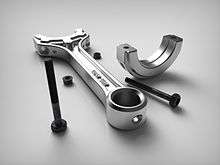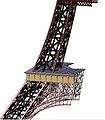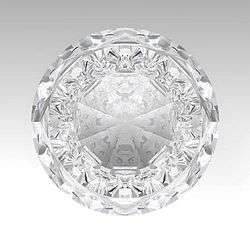CATIA
 | |
| Developer(s) | Dassault Systèmes |
|---|---|
| Initial release | 1977 |
| Stable release |
P3 V5-6 R2017 SP5.0
/ 2018 |
| Operating system | Windows, Unix (server) |
| Type | CAD, CAM, CAE, PLM, 3D |
| License | Proprietary software |
| Website |
www |
CATIA (/kəˈtiːə/, an acronym of computer-aided three-dimensional interactive application) is a multi-platform software suite for computer-aided design (CAD), computer-aided manufacturing (CAM), computer-aided engineering (CAE), PLM and 3D, developed by the French company Dassault Systèmes.
History
CATIA started as an in-house development in 1977 by French aircraft manufacturer AVIONS MARCEL DASSAULT, at that time customer of the CADAM software[1] to develop Dassault's Mirage fighter jet. It was later adopted by the aerospace, automotive, shipbuilding, and other industries.
Initially named CATI (conception assistée tridimensionnelle interactive – French for interactive aided three-dimensional design ), it was renamed CATIA in 1981 when Dassault created a subsidiary to develop and sell the software and signed a non-exclusive distribution agreement with IBM.[2]
In 1984, the Boeing Company chose CATIA V2 as its main 3D CAD tool, becoming its largest customer.
In 1988, CATIA V3 was ported from mainframe computers to Unix.
In 1990, General Dynamics Electric Boat Corp chose CATIA as its main 3D CAD tool to design the U.S. Navy's Virginia class submarine. Also, Lockheed was selling its CADAM system worldwide through the channel of IBM since 1978.
In 1992, CADAM was purchased from IBM, and the next year CATIA CADAM V4 was published.
In 1996, it was ported from one to four Unix operating systems, including IBM AIX, Silicon Graphics IRIX, Sun Microsystems SunOS, and Hewlett-Packard HP-UX.
In 1998, V5 was released and was an entirely rewritten version of CATIA with support for UNIX, Windows NT and Windows XP (since 2001).[3]
In the years prior to 2000, problems caused by incompatibility between versions of CATIA (Version 4 and Version 5) led to $6.1B in additional costs due to years of project delays in production of the Airbus A380.[4]
In 2008, Dassault Systèmes released CATIA V6.[5] While the server can run on Microsoft Windows, Linux or AIX, client support for any operating system other than Microsoft Windows was dropped.[6]
In November 2010, Dassault Systèmes launched CATIA V6R2011x, the latest release of its PLM2.0 platform, while continuing to support and improve its CATIA V5 software.
In June 2011, Dassault Systèmes launched V6 R2012.
In 2012, Dassault Systèmes launched V6 2013x.
In 2014, Dassault Systèmes launched 3DEXPERIENCE Platform R2014x [7] and CATIA on the Cloud, a cloud version of its software.[8][9]
Release history
| Name/Version | Version History Value | Release Date |
|---|---|---|
| Catia v1 | 1981[3] | |
| Catia v2 | 1984[3] | |
| Catia v3 | 1988[3] | |
| Catia v4 | 1993[3] | |
| Catia v5 | 1998[3] | |
| Catia v5 | R7 | 26/6/2001[10] |
| Catia v5 | R17 | 5/9/2006[11] |
| Catia v5 | R18 | 10/2/2007 |
| Catia v5 | R19 | 23/8/2008[12] |
| Catia v6 | R2010 | 23/6/2009[13] |
| Catia v5 | R20 | 16/2/2010[14] |
| Catia v5 | R21 | 5/7/2011[15] |
| Catia v6 | R___ | _/_/2011 |
| Catia v5-6 | R2012 | __/2/2012 |
| Catia v6 | R20 | _20/5/2013 |
Scope of application
Commonly referred to as a 3D Product Lifecycle Management software suite, CATIA supports multiple stages of product development (CAx), including conceptualization, design (CAD), engineering (CAE) and manufacturing (CAM). CATIA facilitates collaborative engineering across disciplines around its 3DEXPERIENCE platform, including surfacing & shape design, electrical, fluid and electronic systems design, mechanical engineering and systems engineering.
CATIA facilitates the design of electronic, electrical, and distributed systems such as fluid and HVAC systems, all the way to the production of documentation for manufacturing.
Mechanical engineering
CATIA enables the creation of 3D parts, from 2D sketches, sheetmetal, composites, molded, forged or tooling parts up to the definition of mechanical assemblies. The software provides advanced technologies for mechanical surfacing & BIW. It provides tools to complete product definition, including functional tolerances as well as kinematics definition. CATIA provides a wide range of applications for tooling design, for both generic tooling and mold & die. In the case of Aerospace engineering an additional module named the aerospace sheetmetal design offers the user combine the capabilities of generative sheetmetal design and generative surface design.[16]
Design
CATIA offers a solution to shape design, styling, surfacing workflow and visualization to create, modify,[17] and validate complex innovative shapes from industrial design to Class-A surfacing with the ICEM surfacing technologies. CATIA supports multiple stages of product design whether started from scratch or from 2D sketches(blueprints). [16]
Systems engineering
The CATIA Systems Engineering solution delivers a unique open and extensible systems engineering development platform that fully integrates the cross-discipline modeling, simulation, verification and business process support needed for developing complex ‘cyber-physical’ products. It enables organizations to evaluate requests for changes or develop new products or system variants utilizing a unified performance based systems engineering approach. The solution addresses the Model Based Systems Engineering (MBSE) needs of users developing today’s smart products and systems and comprises the following elements: Requirements Engineering, Systems Architecture Modeling, Systems Behavior Modeling & Simulation, Configuration Management & Lifecycle Traceability, Automotive Embedded Systems Development (AUTOSAR Builder) and Industrial Automation Systems Development (ControlBuild).
CATIA uses the open Modelica language in both CATIA Dynamic Behavior Modeling and Dymola, to quickly and easily model and simulate the behavior of complex systems that span multiple engineering discipline. CATIA & Dymola are further extended by through the availability of a number of industry and domain specific Modelica libraries that enable user to model and simulate a wide range of complex systems – ranging from automotive vehicle dynamics through to aircraft flight dynamics.[18]
Electrical systems
CATIA v5 offers a solution to formulate the design and manufacturing of electrical systems spanning the complete process from conceptual design through to manufacturing. Capabilities include requirements capture, electrical schematic definition, interactive 3D routing of both wire harnesses and industrial cable solutions through to the production of detailed manufacturing documents including form boards.[19]
Fluid systems
CATIA v5 offers a solution to facilitate the design and manufacturing of routed systems including tubing, piping, Heating, Ventilating & Air Conditioning (HVAC). Capabilities include requirements capture, 2D diagrams for defining hydraulic, pneumatic and HVAC systems, as well as Piping and Instrumentation Diagram (P&ID). Powerful capabilities are provided that enables these 2D diagrams to be used to drive the interactive 3D routing and placing of system components, in the context of the digital mockup of the complete product or process plant, through to the delivery of manufacturing information including reports and piping isometric drawings.[20]
Industries
CATIA can be applied to a wide variety of industries, from aerospace and defense, automotive, and industrial equipment, to high tech, shipbuilding, consumer goods, plant design, consumer packaged goods, life sciences, architecture and construction, process power and petroleum, and services. CATIA V4, CATIA V5, Pro/ENGINEER, NX (formerly Unigraphics), and Dassault Systèmes' own SolidWorks platform are the dominant systems.
Aerospace
The Boeing Company used CATIA V3 to develop its 777 airliner and used CATIA V5 for the 787 series aircraft. They have employed the full range of Dassault Systèmes' 3D PLM products – CATIA, DELMIA, and ENOVIA LCA – supplemented by Boeing-developed applications.[21]
The development of the Indian Light Combat Aircraft has used CATIA V5.
Chinese Xian JH-7A was the first aircraft developed by CATIA V5 when the design was completed on September 26, 2000.
European aerospace Airbus is also using CATIA.[22]
Canadian aircraft maker Bombardier Aerospace has done all of its aircraft design on CATIA V5.[23]
BAE Systems uses CATIA.[24]
The Brazilian aircraft company Embraer uses CATIA V4 and V5 to build all airplanes.
FNSS is using CATIA V5 and V6.[25]
Vought Aircraft Industries uses CATIA V4 and V5 to produce its parts.
The Anglo/Italian Helicopter company AgustaWestland uses CATIA V4 and V5 to design their full range of aircraft.
All subsidiaries of the French company Safran use CATIA for a full range of aerospace, defence and security products.
The Eurofighter Typhoon has been designed using both CATIA V4 and V5.
The main supplier of helicopters to the U.S Military forces, Sikorsky Aircraft Corp., uses CATIA as well.
P3 Voith is using CATIA V6 electrical.[26]
Bell Helicopter, the creator of the Bell Boeing V-22 Osprey, has used CATIA V4, V5 and V6.[27]
Of course, Dassault Aviation is also using CATIA and they are currently working on CATIA V6.[28]
Automotive
Many automotive companies use CATIA to varying degrees, including BMW, Porsche, McLaren Automotive,[29] Chrysler, Honda,[30] Audi,[31] Jaguar Land Rover, Volkswagen, SEAT, Škoda, Bentley Motors Limited, Volvo, Fiat, Benteler International, PSA Peugeot Citroën,[32] Renault,[33] Toyota,[34] Ford, Scania, Hyundai, Tesla Motors,[35] Rolls-Royce Motors, Valmet Automotive, Proton, Elba, Tata motors[36] and Mahindra & Mahindra Limited. Goodyear uses it in making tires for automotive and aerospace and also uses a customized CATIA for its design and development. Many automotive companies use CATIA for car structures – door beams, IP supports, bumper beams, roof rails, side rails, body components because of CATIA's capabilities in Computer representation of surfaces. Bombardier Transportation of Canada is using this software to design its entire fleet of Train engines and coaches. Webasto uses CATIA to design its roof.[37]
Shipbuilding
Dassault Systèmes has begun serving shipbuilders with CATIA V5 release 8, which includes special features useful to shipbuilders. GD Electric Boat used CATIA to design the latest fast attack submarine class for the United States Navy, the Virginia class.[38] Newport News Shipbuilding also used CATIA to design the Gerald R. Ford class of supercarriers for the US Navy.[39] In 2004, it has been adopted by the Beneteau Group for development of new sailing and leisure motor boats.[40]
Industrial equipment
CATIA has a strong presence in the Industrial Equipment industry. Industrial Manufacturing machinery companies like Schuler and Metso use CATIA, as do heavy mobile machinery and equipment companies like Claas, and also various industrial equipment product companies like Alstom Power and ABB Group. Michelin is also using CATIA for its production.[41]
High tech
Some high tech companies are using CATIA to design their products. You can find for example: Nikon,[42] Nokia,[43] Pegatron.[44]
Energy, process and utilities
Suzlon uses CATIA to manufacture turbine blades.[45]
Gamesa uses CATIA to design and manufacture wind turbines.
Consumer packaged goods (CPG) and retail
Procter & Gamble (P&G) is using CATIA to optimize its packagings.[46]

Architecture
Architect Frank Gehry has used the software through the C-Cubed Virtual Architecture company, now Virtual Build Team, to design curvilinear buildings.[47] His technology arm, Gehry Technologies, has been developing software based on CATIA V5 named Digital Project.[48] Digital Project competes for market share with Graphisoft's ARCHICAD, Revit, AECOsim Building Designer and other Building Information Modelling applications. SHoP Architects company is using CATIA for its designs.[49]
File compatibility and CATIA V4 /V5 /V6 conversion
Dassault Systèmes provides utilities to convert CATIA V4 data files so they are accessible to CATIA V5 and CATIA V6. Still, cases show that there can be issues in the data conversion from CATIA V4 to V5 from either differences in the geometric kernel between CATIA V4 and CATIA V5 or by the modelling methods employed by end users. The percentage loss can be minimized by using the appropriate pre-conversion clean-up, choosing the appropriate conversion options, and clean-up activities after conversion.
Conversion from CATIA Version 4 to Version 5 created construction problems for the Airbus A380 aircraft. These problems resulted in $6.1B of additional costs due to years of project delays when aircraft wiring was too short to make connections.
Transition from V5 to V6 is facilitated because they are sharing the same geometric kernel. Third-party file translators also up-convert CATIA files between versions.
Competition
CATIA competes in the high-end CAD/CAM/CAE market with Siemens NX.
Gallery
 North Leg of the Eiffel Tower
North Leg of the Eiffel Tower Concept Product
Concept Product CATIA Rendering
CATIA Rendering CATIA Rendering of a diamond
CATIA Rendering of a diamond
See also
References
- ↑ A history of CATIA by former CEO of Dassault Systèmes Francis Bernard
- ↑ "isicad :: The DASSAULT SYSTEMES Success Story". Retrieved 17 June 2015.
- 1 2 3 4 5 6 "FreeCAD – FreeCAD / CAD History". Retrieved 2017-03-15.
- ↑ "Airbus – A380". Retrieved 17 June 2015.
- ↑ "CATIA CAD Software Review by IndiaCADworks". Retrieved 17 June 2015.
- ↑ "What is CATIA?". Professional industrial design services, High value-added mold and High quality product suppliers. Retrieved 17 June 2015.
- ↑ "Latest release of CATIA". 3ds.com. Retrieved 23 March 2018.
- ↑ "CATIA 3DEXPERIENCE-on-the-Cloud brings High Power Design Tools to Small Design Teams > ENGINEERING.com". Retrieved 17 June 2015.
- ↑ "Social Design on the Cloud with CATIA – Dassault Systèmes " Yanko Design". Retrieved 17 June 2015.
- ↑ "IBM and Dassault Systemes launch CATIA Version 5 Release 7". www.3ds.com. Retrieved 2017-03-15.
- ↑ "Dassault Systèmes and IBM Announce Version 5 Release 17 of their Product Lifecycle Management (PLM) Portfolio". www.3ds.com. Retrieved 2017-03-15.
- ↑ "Dassault Systemes Announces Version 5 Release 19 of its Product Lifecycle Management (PLM) Portfolio". www.3ds.com. Retrieved 2017-03-15.
- ↑ "Dassault Systemes Launches V6R2010". www.3ds.com. Retrieved 2017-03-15.
- ↑ "Dassault Systèmes Launches Release 20 of V5 PLM Platform". www.3ds.com. Retrieved 2017-03-15.
- ↑ "Dassault Systèmes Introduces V5R21". www.3ds.com. Retrieved 2017-03-15.
- 1 2 http://www.mecanicasolutions.com/index.php/plm-product-services/catia/ CATIA solutions
- ↑ Iqbal, Munawar; Wasy, Abdul; Batani, Dimitri; Rashid, Haris; Lodhi, M.A.K. (2012). "Design modification in rotor blade of turbo molecular pump". Nuclear Instruments and Methods in Physics Research Section A: Accelerators, Spectrometers, Detectors and Associated Equipment. 678: 88. doi:10.1016/j.nima.2012.02.030.
- ↑ http://www.claytex.com/products/catia-systems/ CATIA systems engineering reference
- ↑ http://www.3ds.com/products-services/catia/capabilities/mechanical-engineering/electrical-design CATIA electrical systems reference
- ↑ http://www.plmtechnology.no/catia/ CATIA fluid systems reference
- ↑ "Computing & Design/Build Processes Help Develop the 777." Boeing Commercial Airplanes.
- ↑ http://www-03.ibm.com/press/us/en/pressrelease/26182.wss Airbus chooses CATIA V6
- ↑ "Bombardier Aerospace with V5". 3ds.com. Retrieved 23 March 2018.
- ↑ http://www.plmmarketplace.com/upload/Migrating%20from%20CADDS%20to%20CATIA.pdf BAE Systems is using CATIA V6
- ↑ http://www.coe.org/e/in/eid=3&req=info&s=552&all=1 FNSS is using CATIA V6
- ↑ http://catia.cad2design.com/case-studies/273142/CATIA+Customer+p3+voith+CATIA+Electrical+testimony P3 Voith is using CATIA V6
- ↑ https://www.euronext.com/en/content/bell-helicopter-improves-collaboration-and-time-market-dassault-syst%C3%A8mes-v6-plm-platform Bell Helicopter chooses CATIA V6
- ↑ http://www.ainonline.com/aviation-news/dubai-air-show/2013-11-15/new-falcon-5x-bizjet-technological-tour-de-force Dassault Aviation using V6
- ↑ "McLaren – Job Opportunities". Retrieved 17 June 2015.
- ↑ "Honda using CATIA" (PDF). 3ds.com. Retrieved 23 March 2018.
- ↑ "Upheaval in automotive PLM as car companies change partners". Retrieved 17 June 2015.
- ↑ "Peugeot S.A. signs a 3-year contract for 1,300 CATIA licenses". Retrieved 17 June 2015.
- ↑ http://www.cadcam-group.eu/Slike/PDFs/Renault.pdf Renault chooses CATIA V6
- ↑ Joann Muller (2 February 2010). "Toyota: Computer-Addled Design?". Forbes. Retrieved 17 June 2015.
- ↑ https://www.bloomberg.com/apps/news?pid=conewsstory&tkr=DSY:FP&sid=agpV.N3zaAlA Tesla chooses CATIA V6
- ↑ https://idc-community.com/manufacturing/manufacturing-value-chain/dassault_systemes_3dexperience_and_its_adoption_in_indian_auto_indus Tate chooses CATIA V6
- ↑ http://www.automotiveit.com/webasto-upgrades-to-catia-v6/news/id-006085 Webasto is using CATIA V6
- ↑ Conklin, James. "Realizing Life Cycle Cost Savings Through Standardization". Defense Standardization Program. Department Of Defense.
- ↑ http://www.naval-technology.com/projects/cvn-21/ Gerald R. Ford class using CATIA
- ↑ "Beneteau Group Selects PLM Shipbuilding Solutions From IBM and Dassault Systèmes".
- ↑ http://www.3ds.com/fileadmin/COMPANY/Investors/Earnings/10Q2/10Q2-Earnings-Newswire-conf-call-EN.pdf Michelin is using CATIA V6
- ↑ http://gfxspeak.com/2011/11/22/nikon-adopts-dassault-systemes-v6-to-upgrade-catia-replace-teamcenter/ Nikon is using CATIA V6
- ↑ http://perspectives.3ds.com/events/nokia-chicken-and-3ds-ecf2010/ Nokia is using CATIA V6
- ↑ http://www.3ds.com/fileadmin/COMPANY/Investors/Earnings/12Q3/12Q3-Earnings-Newswire-conf-call-EN.pdf Pegatron is using CATIA V6
- ↑ http://www.3ds.com/fileadmin/customer-stories/pdf/3DS_Case_study_SUZLON_VAR_English_Version_HD.pdf Suzlon is using CATIA V6
- ↑ http://www.deskeng.com/de/dassault-systemes-technology-helps-p-and-g-optimize-its-packaging-and-artwork-process/ P&G is using CATIA V6
- ↑ Day, Martin (September–October 2003). "Gehry, Dassault and IBM Too". AEC Magazine. Archived from the original on 2005-12-01. Retrieved 2007-03-07.
- ↑ "Digital Project". Gehry Technologies. Archived from the original on 2007-02-05. Retrieved 2007-03-07.
- ↑ http://www.3ds.com/fileadmin/customer-stories/pdf/DS_SHoP_CaseStudy_Jan2014_hi.pdf SHoP is using CATIA V6
External links
| Wikimedia Commons has media related to CATIA. |